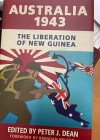Australia 1943: The Liberation of New Guinea
Written by: Peter Dean (ed),
Penguin Australia, 2013,
ISBN 9781107037991, 337pp,
Reviewed by: Matt Miller
Australia 1943: The Liberation of New Guinea is an excellent snapshot of both familiar and unexplored aspects of the war in New Guinea. New Guinea was a complicated battlefield with a vast geography and unfamiliar names which will challenge the uninitiated. The book endeavours to explore the battle for New Guinea from the strategic heights of political challenges in Australia to the combat logistics services in the jungle. The capture of a single year of war and the broad cross- section of topics has, to an extent, streamlined what would have previously required the reading of numerous voluminous texts to gain familiarity with the topics.
The first challenge for the uninitiated is to understand the vast scope of New Guinea’s geography. For the American reader, the sheer scale of unfamiliar names of landings and battle sites will present a significant challenge. These geographic challenges will be exacerbated by the general ignorance of the New Guinea campaign in favour of places such as Tarawa, Iwo Jima and Okinawa. Throughout Australia 1943, the authors of individual chapters provide an excellent framework, with maps and geographic context for a campaign that stretched across one of the world’s largest islands.
Australia 1943 captures an important year of transitions in the South West Pacific Area (SWPA). First, the Japanese transitioned into a retrograde and sometimes ‘die in place’ defence across the theatre. The second major transition was that of the United States which, after some initial stumbles in the SWPA, became the dominant combat power in the Pacific, first offsetting the Royal Australian Air Force and the Royal Australian Navy and finally the Australian Army.
This volume addresses the evolution of strategy in 1943 from three angles — the United States, Australia and Japan — providing a healthy look at the strategy under which the battles of New Guinea would unfold. Readers familiar with General MacArthur’s complicated and sometimes questionable command style will find the Australian perspective on theatre command politics throughout the book highly beneficial to understanding the complex relationships between the countries.
Equally important is the inclusion of a chapter on Japan’s strategy in the SWPA, offering a deeper view of the reasoning behind Japan’s actions as opposed to publications that more commonly use Japan’s role and actions to highlight Allied stories of Pacific victory. As noted, 1943 was a significant year for Japanese military strategy with the shift to retrograde operations in unforgiving, disease- infested terrain where the possibility of withdrawal or relief seemed ever less likely.
The often lesser acknowledged fields of military endeavours, such as logistics, are provided their own chapters in Australia 1943. This helps the reader to grasp the monumental challenge of Australian and American support for ground combat troops in the mud and mountains of New Guinea. It also highlights the inability of the Japanese to support their overextended defensive ring in the South Pacific.
Although it is uncommon for support functions such as logistics to be given such prominence in this type of book, this information is invaluable to understanding the scope of operations in New Guinea.
Australia 1943 offers fair praise for the Australian infantry who, in this time and space, had transitioned from the deserts of North Africa and the Middle East to become a highly competent jungle force. The partnership with the United States turned a tactically savvy light infantry into a combined arms machine in New Guinea. As was keenly noted in the book, 1943 saw the Australian infantry’s increased command of both artillery and air support against the Japanese fortifications in the Markham and Ramu valleys.
The contributors to this volume present the war in New Guinea in a fresh light.
At first glance, the chapters appear to draw extensively on previously published sources. Normally, this could be considered a great disadvantage as many of the books on New Guinea indulge in circular sourcing to the extent that the reader receives the impression that nothing new has been written on the subject since the 1970s. Fortunately, none of the chapters in this book engages in the reissue of famous quotes, redundant statistics, or verbatim accounts of battles from the official histories.
A beneficial addition would have been a chapter on the various Australian capabilities and echelons of intelligence operating in New Guinea during 1943. This unexplored area of the only theatre of the Second World War devoid of the Office of Strategic Services could have proven a valuable addition to the study of the Australian military and the liberation of New Guinea.
While this book will certainly be of great interest to the Australian reader, I believe it will be of greater importance to the American reader who will be less familiar with New Guinea. In addition, the historical insights into the conduct of jungle and amphibious warfare in a coalition environment offer more value to future military leaders than the study of assaults against isolated coral atolls. I would recommend that Australia 1943: The Liberation of New Guinea and its companion Australia 1942: In the Shadow of War be added to any military reading list related to the conduct of military affairs in the Pacific.

